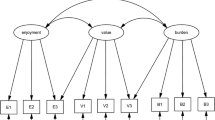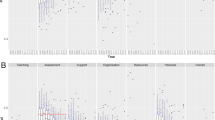Abstract
What causes a student to participate in a survey? This paper looks at participation across multiple surveys to understand survey non-response; by using multiple surveys we minimize the impact of survey salience. Students at a selective liberal arts college were administered four different surveys throughout the 2002–2003 academic year, and we use the number of surveys participated in to understand how student characteristics such as demographics, engagement and Holland personality type affect cooperation. We find that survey respondents are more likely to be female and socially engaged, less likely to be on financial aid, more likely to be an investigative personality type and less likely to be an enterprising personality type.
Similar content being viewed by others
References
L. L. M. Adams D. Gale (1982) ArticleTitleSolving the quandry between questionnaire length and response rate in educational research Research in Higher Education 17 IssueID3 231–240
InstitutionalAuthorNameAmerican Association for Public Opinion Research (2004) Standard definitions: Final dispositions of case codes and outcome rates for surveys KS Lenexa
A. L. Aviv J. M. Zelenski L. Rallo R. J. Larsen (2002) ArticleTitleWho comes when: Personality differences in early and later participation in a university subject pool Personality and Individual Differences 33 487–496
M. R. Barrick M. K. Mount R. Gupta (2003) ArticleTitleMeta-analysis of the relationship between the Five-Factor Model of personality and Holland’s Occupational types Personal Psychology 56 46–74
Bradburn, N. M. (1978). Respondent burden. Paper presented at the The American Statistical Association, Proceedings of the Survey Research Methods Section.
M. Brennan J. Hoek (1992) ArticleTitleThe behavior of respondents, nonrespondents, and refusers across mail surveys Public Opinion Quarterly 56 IssueID4 530–535
H. Cooper A. H. Baumgardner A. Strathman (1991) ArticleTitleDo students with different characteristics take part in psychology experiments at different times of the semester? Journal of Personality 59 109–127
M. P. Couper (1997) ArticleTitleSurvey introductions and data quality Public Opinion Quarterly 61 IssueID2 317–338
M. P. Couper M. W. Traugott M. J. Lamias (2001) ArticleTitleWeb survey design and administration Public Opinion Quarterly 65 250–253
S. D. Crawford M. P. Couper M. J. Lamias (2001) ArticleTitleWeb surveys: Perceptions of burden Social Science Computer Review 19 IssueID2 146–162
R. Curtin S. Presser E. Singer (2000) ArticleTitleThe effects of response rate changes on the index of consumer sentiment Public Opinion Quarterly 64 413–428
E. De Leeuw W. Heer (2002) Trends in household survey nonresponse: A longitudinal and international comparison R. M. Groves D. A. Dillman J. L. Eltinge R. J. A. Little (Eds) Survey Nonresponse John Wiley & Sons New York
E. Dey (1997) ArticleTitleWorking with low survey response rates: The efficacy of weighting adjustments Research in Higher Education 38 IssueID2 215–227
C. J. Dommeyer E. Moriarty (2000) ArticleTitleComparing two forms of an email survey: Embedded vs. attached International Journal of Market Research 42 IssueID1 39–50
R. Evans E. Donnerstein (1974) ArticleTitleSome implications for psychological research of early versus late term participation by college students Journal of Research in Personality 8 102–109
J. Goyder (1982) ArticleTitleFurther evidence on factors affecting response rates to mailed questionnaires American Sociological Review 47 IssueID4 550–553
J. Goyder (1986) ArticleTitleSurveys on surveys: Limitations and potentialities Public Opinion Quarterly 50 IssueID1 27–41
J. Goyder (1987) The Silent Minority: Nonrespondents in Sample Surveys Westview Press Boulder
J. Goyder K. Warriner S. Milller (2002) ArticleTitleEvaluating socio-economic status (SES) bias in survey nonresponse Journal of Official Statistics 18 IssueID1 1–11
W. H. Greene (1997) Econometric Analysis Prentice Hall Upper Saddle River, NJ
R. M. Groves R. B. Cialdini M. P. Couper (1992) ArticleTitleUnderstanding the decision to participate in a survey Public Opinion Quarterly 56 475–495
R. M. Groves M. P. Couper (1996) ArticleTitleContact-level influences on cooperation in face-to-face surveys Journal of Official Statistics 12 IssueID1 63–83
R. M. Groves E. Singer A. Corning (2000) ArticleTitleLeverage-saliency theory of survey participation Public Opinion Quarterly 64 299–308
T. A. Heberlein R. Baumgartner (1978) ArticleTitleFactors affecting response rates to mailed questionnaires: A quantitative analysis of the published literature American Sociological Review 43 IssueID4 447–462
J. L. Holland (1966) The Psychology of Vocational Choice Blaisdell Waltham, MA
J. L. Holland (1985) Making Vocational Choices Prentice-Hall Englewood Cliffs, NJ
J. Hutchinson N. Tollefson H. Wigington (1987) ArticleTitleResponse bias in college freshman’s response to mail surveys Research in Higher Education 26 IssueID1 99–106
J. S. Johnson R. R. Mowrer (2000) ArticleTitleMail surveys among college students:Do initial responders score differently from nonresponders on the 16PF? Psychological Reports 86 901–908
D. O. Kaldenberg H. F. Koenig B. W. Becker (1994) ArticleTitleMail survey response rate patterns in a population of the elderly: Does response deteriorate with age? Public Opinion Quarterly 58 IssueID1 68–76
D. Kandel J. L. Raveis (1983) ArticleTitleSex differences in the characteristics of members lost to a longitudinal panel: A speculative research note Public Opinion Quarterly 47 IssueID4 567–575
Kojetin, B. A., Borgida, E. , and Snyder, M. (1993). Survey Topic Involvement and Nonresponse Bias. Paper presented at the Proceeding of the Section on Survey Research Method, Volume II, American Statistical Association
G. D. Kuh (2003) The National Survey of Student Engagement: Conceptual Framework and Overview of Psychometric Properties Indiana University Center for Postsecondary Research Bloomington, IN
N. Kwak B. Radler (2002) ArticleTitleA comparison between mail and web surveys: Response pattern, respondent profileand data quality Journal of Official Statistics 18 IssueID2 257–273
V. M. H. C. J. Lahaut H. A. M. Jansen D. van de Mheen H. F. L. Garretsen J. E. E. Verdurmen A. van Dijk (2003) ArticleTitleEstimating non-response bias in a survey on alcohol consumption: Comparison of response waves Alcohol and Alcoholism 38 128–134
L. M. Larson P. J. Rottingham F. Borgen (2002) ArticleTitleMeta-analysis of big six interests and big five personality factors Journal of Vocational Behavior 61 217–239
H. Laurie R. Smith L. Scott (1999) ArticleTitleStrategies for reducing nonresponse in a longitudinal panel survey Journal of Official Statistics 15 IssueID2 269–282
H. J. Liberty (1993) ArticleTitleThe relationship between extraversion and time of data collection Personality and Individual Differences 14 835–836
I.-F. Lin N. C. Schaeffer (1995) ArticleTitleUsing survey participants to estimate the impact of nonparticipation Public Opinion Quarterly 59 236–258
J. S. Long (1997) Regression Models for Categorical and Limited Dependent Variables Sage Publications Thousand Oaks, CA
F. Lowe T. C. McCormick (1955) ArticleTitleSome Survey Sampling Biases Public Opinion Quarterly 19 303–315
R. R. McCrae P. T. J. Costa (1996) Toward a new generation of personality theories: Theoretical contexts for the five-factor model J. S. Wiggins (Eds) The Five-Factor Model of Personality:Theoretical Perspectives Guilford New York 51–87
S. W. McDaniel C. S. Madden P. Verille (1987) ArticleTitleDo topic differences affect survey non-response? Journal of the Market Research Society 29 55–66
D. L. Moore J. Tarnai (2002) Evaluating nonresponse error in mail surveys R. M. Groves D. A. Dillman J. L. Eltinge R. J. A. Little (Eds) Survey Nonresponse John Wiley & Sons New York 197–211
MountM. K., Barrick, M. A., Scullen, S. M., and Rounds, J. (2004, April 2004). Higher Order Dimensions of Personality Traits and Interests. Paper presented at the Annual meeting of the Society for Industrial and Organizational Psychology, Chicago.
National Center for Education Statistics (2002) National Postsecondary Student Aid Study 1999–2000 (NPSAS:2000), CATI Nonresponse Bias Analysis Report (No. 2002–03) Washington, DC
National Survey of Student Engagement (2003). The College Student Report: 2003 Overview.
L. N. Pealer R. M. Weiler R. M. Pigg SuffixJr D. Miller S. M. Dorman (2001) ArticleTitleThe feasibility of a web-based surveillance system to collect health risk data from college students Health Education & Behavior 28 IssueID5 547–559
Porter, S. R., Umbach, P. D. (2002) College Major Choice: An Analysis of Person-Environment Fit. Paper presented at the Association for Institutional Research. TorontoCanada
S. R. Porter P. D. Umbach (2004) ArticleTitleWhat works best? Collecting alumni data with multiple technologies AIR Professional File 90 1–10
S. R. Porter M. E. Whitcomb (2003a) ArticleTitleThe impact of contact type on web survey response rates Public Opinion Quarterly 67 IssueID4 579–588
S. R. Porter M. E. Whitcomb (2003b) ArticleTitleThe impact of lottery incentives on student survey response rates Research in Higher Education 44 IssueID4 389–407
S. R. Porter M. E. Whitcomb W. H. Weitzer (2004) Multiple surveys of students and survey fatigue S. R. Porter (Eds) Overcoming Survey Research Problems, New Directions for Institutional Research (Vol. 121) Jossey-Bass San Francisco
R. J. Roman G. B. Moskowitz M. I. Stein R. F. Eisenberg (1995) ArticleTitleIndividual differences in experiment participation: Structureautonomy, and the time of semester Journal of Personality 63 113–138
L. J. Sax S. K. Gilmartin A. N. Bryant (2003) ArticleTitleAssessing response rates and nonresponse bias in web and paper surveys Research in Higher Education 44 IssueID4 409–432
L. J. Sax J. A. Lindholm A. W. Astin W. S. Korn K. M. Mahoney (2001) The American Freshman:National Norms for Fall 2001 Higher Education Research Institute UCLA, Los Angeles, CA
E. Singer R. M. Groves A. D. Corning (1999) ArticleTitleDifferential incentives:Beliefs about practices, perceptions of equity, and effects on survey participation Public Opinion Quarterly 63 251–260
E. Singer J. van Hoewyk M. P. Maher (2000) ArticleTitleExperiments with incentives in telephone surveys Public Opinion Quarterly 64 171–188
J. C. Smart K. A. Feldman C. A. Ethington (2000) Academic Disciplines:Holland’s Theory and the Study of College Students and Faculty Vanderbilt University Press Nashville
T. W. Smith (1995) ArticleTitleTrends in nonresponse rates International Journal of Public Opinion Research 7 157–171
K. Smith T. Bers (1987) ArticleTitleImproving alumni survey response rates: An experiment and cost-benefit analysis Research in Higher Education 27 IssueID3 218–226
C. G. Steeh (1981) ArticleTitleTrends in nonresponse rates, 1952–1979 Public Opinion Quarterly 59 66–77
C. D. Stevens R. A. Ash (2001) ArticleTitleThe conscientiousness of students in subject pools: Implications for “laboratory” research Journal of Research in Personality 35 91–97
A. L. Stinchcombe C. Jones P. Sheatsley (1981) ArticleTitleNonresponse bias for attitude questions Public Opinion Quarterly 45 IssueID3 359–375
Tuckel, P., and O’Neill, H. (2002). The vanishing respondent in telephone surveys. Journal of Advertising Research 26–48.
P. D. Umbach S. R. Porter (2002) ArticleTitleHow do academic departments impact student satisfaction? Understanding the contextual effects of departments Research in Higher Education 23 IssueID2 209–233
P. Van Kenhove K. Wijnen K. De Wulf (2002) ArticleTitleThe influence of topic involvement on mail-survey response behavior Psychology & Marketing 19 293–301
L. F. Voigt T. D. Koepsell J. R. Daling (2003) ArticleTitleCharacteristics of telephone survey respondents according to willingness to participate American Journal of Epidemiology 157 66–73
WhitcombM. E., and PorterS. R. (2004). Email contacts: A test of complex graphical designs. Social Science Computer Review 22(3): 370–376.
Zelenski, J. M., Rusting C. L., Larsen, R. J.(2000). Personality Differences and Consistency in the Time of Experiment Participation. Paper presented at the Poster presented at The Annual Meeting of the Society for Personality and Social Psychology. NashvilleTN
B. J. Zusman P. Duby (1987) ArticleTitleAn evaluation of the use of monetary incentives in postsecondary survey research Journal of Research and Development in Education 20 IssueID4 73–78
Author information
Authors and Affiliations
Corresponding author
Rights and permissions
About this article
Cite this article
Porter, S.R., Whitcomb, M.E. Non-response in student surveys: The Role of Demographics, Engagement and Personality. Res High Educ 46, 127–152 (2005). https://doi.org/10.1007/s11162-004-1597-2
Received:
Issue Date:
DOI: https://doi.org/10.1007/s11162-004-1597-2




